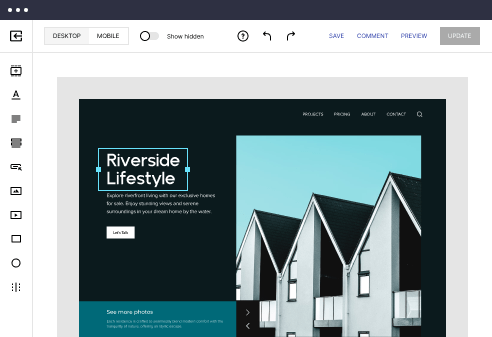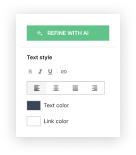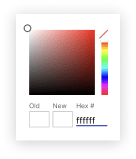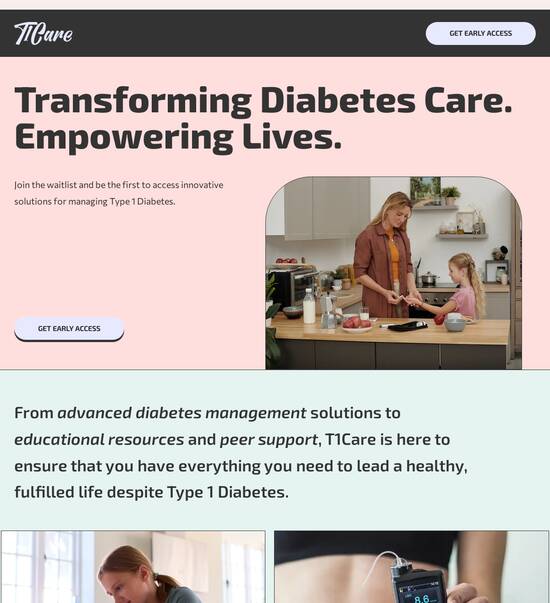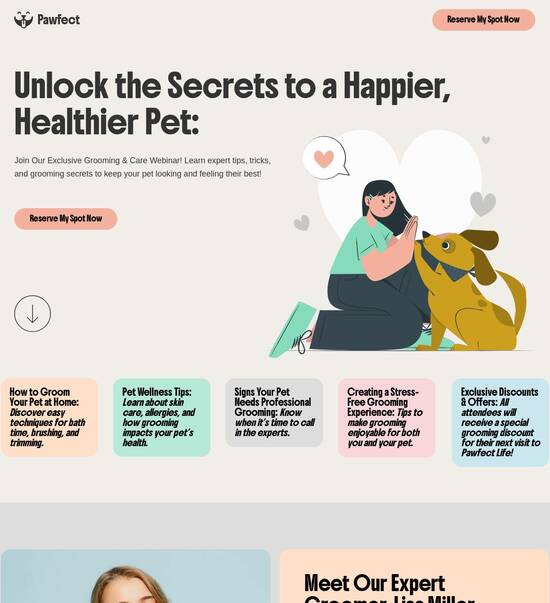
Landing page template with interactive image carousel widget
Explore Similar TemplatesAbout template
Use landing page templates with interactive image carousel widget and make your communications easy and transparent. Try our solution today.
Recommended templates
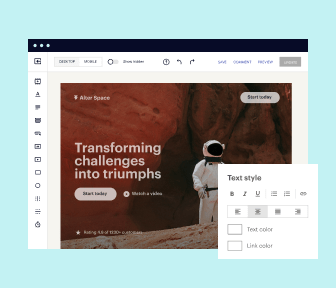
Easy to build without coding
With the intuitive drag-and-drop builder, anyone on your team can create high-converting pages without any knowledge of code or design. Make enhancements to your landing page with custom widgets using Javascript, HTML/CSS, or third-party scripts.
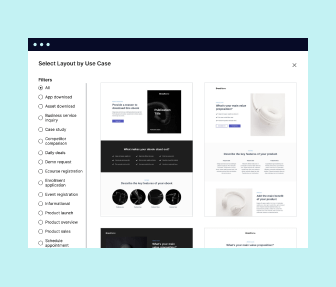
Multiple layouts for any industry and goal
Select from 500+ landing page layouts built to boost conversions across industry-specific scenarios. Customize them by adjusting fonts, adding images, and generating on-brand content with the AI assistant. Quickly scale with Instablocks® and Global Blocks that you can save, reuse, and update globally.

Loads fast and looks polished on any device
Every template is responsive, which means they present professionally on any device and load blazingly fast with our Thor Render Engine. You can also power them up with Google AMP technology to deliver an unparalleled mobile experience and drive higher conversions.
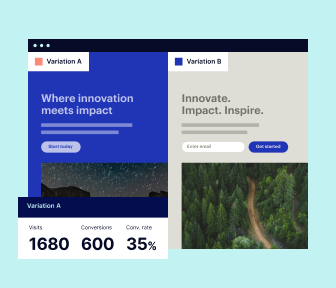
Robust analytics & experimentation
Get real-time updates and reporting across all your devices, showing the number of visitors, conversions, cost-per-visitor, and cost-per-lead. Launch AI-powered experiments, run A/B tests, and use heatmaps to analyze user behavior, then optimize your landing page to maximize conversions.
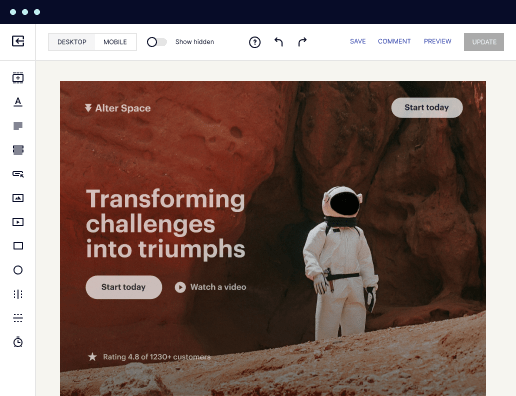
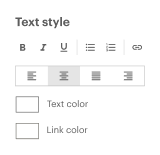
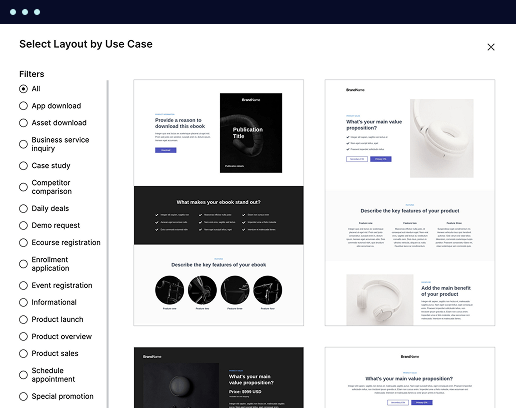


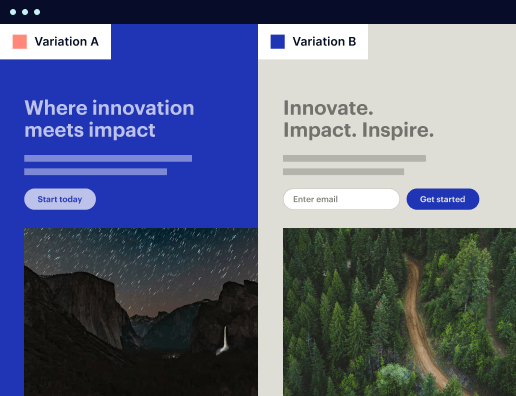
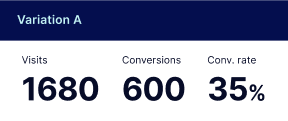
Easy to build without coding
With the intuitive drag-and-drop builder, anyone on your team can create high-converting pages without any knowledge of code or design. Make enhancements to your landing page with custom widgets using Javascript, HTML/CSS, or third-party scripts.
Multiple layouts for any industry and goal
Select from 500+ landing page layouts built to boost conversions across industry-specific scenarios. Customize them by adjusting fonts, adding images, and generating on-brand content with the AI assistant. Quickly scale with Instablocks® and Global Blocks that you can save, reuse, and update globally.
Loads fast and looks polished on any device
Every template is responsive, which means they present professionally on any device and load blazingly fast with our Thor Render Engine.
Robust analytics & experimentation
Get real-time updates and reporting across all your devices, showing the number of visitors, conversions, cost-per-visitor, and cost-per-lead. Launch AI-powered experiments, run A/B tests, and use heatmaps to analyze user behavior, then optimize your landing page to maximize conversions.
All the features you need to build landing page carousel
Explore more featuresLearn how to build carousel landing page
FAQs
Leading the way in building high-performing landing pages





Maximize Your ROI with Instapage's Powerful Landing Page Template Featuring an Interactive Image Carousel Widget
Instapage's landing page templates are engineered to enhance your digital marketing campaigns, making them a crucial tool for marketers looking to optimize conversions and scale their efforts. A specific highlight is the interactive image carousel widget that not only captivates visitors but also effectively showcases multiple elements of your offering without overwhelming the page. This guide dives deep into maximizing your landing page effectiveness with these templates.
Why Use an Interactive Image Carousel Widget?
Interactive image carousels can significantly elevate user engagement on landing pages. They allow you to present various products, testimonials, or services seamlessly. Here’s why they matter:
- Enhanced engagement: Users can interact with multiple images, leading to longer time spent on the page and reduced bounce rates.
- Showcase variety: Highlight different products or features without cluttering the layout.
- Visual storytelling: Users can see your brand story unfold as they navigate through the images.
Step 1: Selecting the Right Template
Choose a landing page template that integrates well with the interactive image carousel widget. Consider the aesthetics and layout that best align with your branding.
- Check for responsiveness: Ensure the template adapts well to different devices for optimal user experience.
- Prioritize speed: Choose templates that load quickly to avoid losing potential leads.
- Look for customization options: Select templates that allow adjustments to align fully with your campaign goals.
Step 2: Implementing the Image Carousel
Once the template is selected, it's time to integrate the interactive image carousel. Here's how to effectively implement it:
- Upload high-quality visuals: Ensure all images are high resolution to maintain professionalism.
- Add compelling captions: Provide context that enhances the visual content and drives home your value proposition.
- Utilize engaging animations: Implement smooth transitions to enhance user experience without being distracting.
Step 3: Optimize and Test Your Landing Page
Finally, optimization is key. Use A/B testing to ascertain the effectiveness of your image carousel and overall landing page performance.
- Monitor analytics: Use Instapage's analytics dashboard to see how users interact with the carousel.
- Gather feedback: Use surveys or feedback forms to understand user experience better.
- Iterate continuously: Make data-driven changes based on performance metrics to continually improve conversion rates.
In conclusion, using an interactive image carousel within your landing page template can significantly enhance user engagement and boost conversion rates. By carefully selecting your template, implementing engaging visuals, and continuously optimizing your approach, you position your digital campaigns for more significant ROI.
Ready to take your landing pages to the next level? Start with Instapage today and experience how these interactive elements can transform your marketing strategies.
People also ask about Landing page template with interactive image carousel widget
Landing page template with interactive image carousel widget
The evolution of landing pages: integrating interactivity
Landing pages have come a long way from their simple, static roots. Traditional landing pages relied on text and a few images to convey information. However, as user expectations have evolved, marketers recognize that their online presence must captivate visitors and encourage interaction. Today's digital landscape demands that businesses prioritize user engagement, transforming their landing pages into immersive experiences that invite exploration.
This shift underscores the importance of integrating dynamic elements, like interactive image carousels, which not only enhance the visual appeal of landing pages but also promote increased user interaction. In an era where attention spans are shorter than ever, engaging designs that respond to user actions are critical for retaining visitors and driving conversions.
The role of interactive elements
Interactivity in web design refers to the responsiveness of a page to user input. This could manifest as elements that animate, respond, or transform based on user activity. By adding interactive features, such as image carousels, marketers empower users to engage with content actively, encouraging longer dwell times and fostering a connection with the brand. Such interactivity acts as a catalyst for improved user experience, ensuring visitors not only consume content but also participate in the storytelling aspect of the page.
Unpacking the interactive image carousel widget
An image carousel widget is an innovative component that enables multiple images to be displayed sequentially within a single space on a landing page. Designed for smooth transitions between images, carousels allow for storytelling through visuals while maintaining a clean and organized appearance. They serve as a space-saving solution to showcase a multitude of images without crowding the page.
Compared to static images, carousels offer a more engaging method of presenting visuals. While static images can convey a message, they cannot capture the dynamic nature of a narrative or product promotion. With image carousels, users can experience a versatile portrayal of offerings, driving interest and encouraging exploration.
Slide navigation controls, including arrows or pagination dots that allow users to move between images.
Responsive design ensures that carousels perform well on various devices, from desktops to smartphones.
Transition effects, such as fades or slides, create a more engaging experience as images shift.
Design considerations for effective image carousels
When designing an image carousel, aesthetics play a crucial role in capturing audience attention. Selecting the right photo sizes is key; images should be large enough to showcase detail while remaining optimized for fast loading times. Quality matters, as high-resolution images reflect professionalism and enhance user perception of the brand.
In terms of color schemes and typography, it is essential that they complement the visuals in the carousel. An effective design harmonizes imagery with text, ensuring readability and maintaining the user's focus on the message being communicated. Each element should work together to create a cohesive visual narrative.
Carousel layout strategies
When considering how to lay out a carousel, marketers often choose between single-row and multi-column designs. Single-row carousels tend to be less cluttered, allowing users to focus on one image at a time. Multi-column carousels can display several images simultaneously, appealing to users who enjoy variety at a glance. However, care must be taken to prevent overwhelming visitors.
Additionally, incorporating text overlays and calls to action (CTAs) directly within slides can effectively drive user action. Strategically placed CTAs can guide users through a narrative, ensuring they understand the value proposition of the content they are engaging with. Understanding the spatial hierarchy within the carousel layout is essential for naturally guiding user attention from the main visuals to the supporting text.
The benefits of using image carousels on landing pages
One of the primary benefits of incorporating image carousels into landing pages is their potential to enhance engagement metrics. Data shows that interactive features lead to higher click-through rates, as visitors are encouraged to explore different images or content options. Dwell time also tends to increase; users are more likely to remain on a page longer when interacting with engaging visual content.
Moreover, better engagement translates to improved conversion rates. By showcasing visual content effectively, businesses can push potential customers toward desired actions, whether that be signing up for a newsletter or making an immediate purchase. An ideal scenario for using carousels could include e-commerce promotions, highlighting products in a visually appealing manner, or portfolio showcases for designers that showcase their best work.
E-commerce promotion: Carousels can present a rotating selection of products to inform customers and encourage clicks.
Portfolio showcases for designers: Featuring work through carousels provides a dynamic product presentation.
Event registrations with promotional visuals: Convey engaging event details through appealing imagery.
User experience: tailoring carousels for diverse audiences
Understanding user behavior when interacting with image carousels is paramount for designing effective landing pages. Different demographics engage uniquely with content, influencing what design choices resonate best with them. For instance, younger audiences might be more inclined to interact with modern, sleek carousels, while older audiences may prefer simpler designs that limit distractions.
Beyond aesthetics, accessibility must be a priority in carousel design. Marketers must ensure carousels are navigable not only by mouse but also via keyboard, which is vital for users with disabilities. Additionally, businesses should consider screen reader compatibility, allowing visually impaired users to access content effectively.
Optimizing carousels for all users fosters inclusive design.
Ensuring keyboard navigation promotes ease of use.
Screen reader compatibility enhances accessibility for visually impaired audiences.
Implementing the carousel widget: a step-by-step guide
Choosing the right platform for implementing an image carousel is critical. Instapage is recognized as a leading landing page builder, providing marketers with a robust selection of built-in features, including a carousel widget, that simplifies the design process. Integrating such a tool offers a creative and efficient solution for businesses aiming to enhance user interaction and retention.
Creating a carousel from scratch can seem daunting, but the process is straightforward. First, gather high-quality images that align with your messaging; next, use Instapage’s drag-and-drop functionality to place an image carousel on your landing page. From there, customization options allow entrepreneurs to adjust colors, fonts, and transition effects to craft a personalized user experience.
Step-by-step setup guides are commonly available to simplify the creation process.
Ensure to explore customization options for personal branding.
Testing carousel functionality is essential before final publication.
Testing and optimizing carousels for performance
Once a carousel is implemented, testing becomes crucial to assess its effectiveness. A/B testing methodologies can be used to compare the performance of different carousel designs, layouts, or content. By tracking user interaction and conversion rates, marketers can gather actionable insights and refine their approach to maximize engagement.
Using analytics tools helps identify which images or transitions resonate with users. This data-driven approach allows businesses to make informed decisions about content, ultimately leading to higher conversion rates. Examining user interactions fosters a culture of continuous iteration and improvement, ensuring that carousels remain relevant and effective.
Real-world applications and success stories
Many brands have successfully leveraged interactive image carousels in their landing pages to enhance user interaction and drive conversions. Case studies provide valuable insights into how these widgets can transform engagement metrics. Brands incorporating detailed analytics saw significant improvements in both click-through rates and conversion rates post-implementation.
The art of storytelling through image sequences also plays a vital role in carousel effectiveness. For instance, designers showcasing their portfolio can create a narrative flow through carefully chosen images, guiding potential clients through their creative journey. Best practices highlight the importance of aligning imagery with messaging, ensuring that each slide contributes to the overall narrative of the brand.
Brands that integrate carousels consistently outperform those that don't.
Case studies can reveal transformations in landing page engagement.
Visual storytelling can guide potential customers effectively through portfolios.
Future innovations in carousel widget technology
The evolution of web design continues to progress, and with it comes predictions for the future of interactive carousel technology. Emerging trends signal a growing integration of enhanced user experiences, including artificial intelligence features that anticipate user preferences. This could lead to more personalized experiences tailored to individual browsing behaviors.
Moreover, forthcoming enhancements may incorporate multimedia elements such as videos or GIFs, further enriching the carousel experience. By allowing visitors to engage with varied content forms, brands can offer a more robust interaction model, ultimately increasing engagement and driving conversions.
Emerging trends in web design will focus on enhancing user interaction.
Artificial intelligence could introduce personalized carousel experiences.
Multimedia elements may redefine how carousel content engages users.
Integrating image carousels with broader marketing strategies
To maximize the effectiveness of image carousels in landing pages, they should align with overall marketing strategies. Implementing SEO-friendly practices, such as using descriptive alt text and captions, can spotlight carousel images and enhance organic traffic. By doing so, businesses can drive qualified leads to their landing pages, improving the overall effectiveness of their marketing efforts.
Furthermore, incorporating user-generated content within carousels serves to build credibility and trust. Showcasing customer photos and testimonials can powerfully connect brands with potential customers, proving the value of products or services. Such elements of social proof not only enrich the carousel’s content but also make the users feel included and valued in the brand's narrative.
Optimizing alt text can improve search engine visibility.
User-generated content within carousels fosters community engagement.
Building credibility through testimonials enhances brand trust.
Conclusion: transforming user journeys with carousel innovations
In summary, the integration of interactive image carousels into landing page design plays an integral role in fostering engaging user experiences. These tools not only enhance visual storytelling but also empower marketers to drive conversions through interactive engagement. As the landscape of digital design continues to evolve, embracing these innovations will be paramount for brands looking to optimize their presence and connect effectively with their audiences.
Looking ahead, the future of interactive carousels promises further advancements that will enhance user interactions. By staying abreast of these developments, businesses can continue to innovate their digital strategies, ensuring they remain relevant and effective in an ever-changing online environment.
Ready to skyrocket conversions?
Supercharge your ad campaigns with high-performing landing pages
Get started